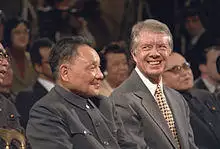
The Joint Communiqué on the Establishment of Diplomatic Relations of January 1, 1979, established official relations between the United States and the People's Republic of China (commonly called "China").
Its announcement coincided with the ending of U.S. official recognition of the Republic of China (now commonly known as "Taiwan"), which was announced by President Jimmy Carter in December 1978. Carter also announced the withdrawal of all U.S. military personnel from Taiwan and the end to the Sino-American Mutual Defense Treaty signed with the ROC. However, the Taiwan Relations Act passed by the unequivocal support of US Congress (and signed by the Carter Administration)[1] shortly thereafter continued to provide the legal framework as a US domestic law to maintain commercial, cultural, and other relations without official Government representation and without diplomatic relations of the unofficial relations in the form of the American Institute in Taiwan.
Beyond formal recognition, the communiqué reaffirms the principles agreed upon in the Shanghai Communiqué, released almost seven years earlier.
See also
- One-China policy
- Three Communiques
- Sino-American relations
References
- ^ "Jimmy Carter: Taiwan Relations Act Statement on Signing H.R. 2479 Into Law". Presidency.ucsb.edu. Retrieved 2012-07-23.